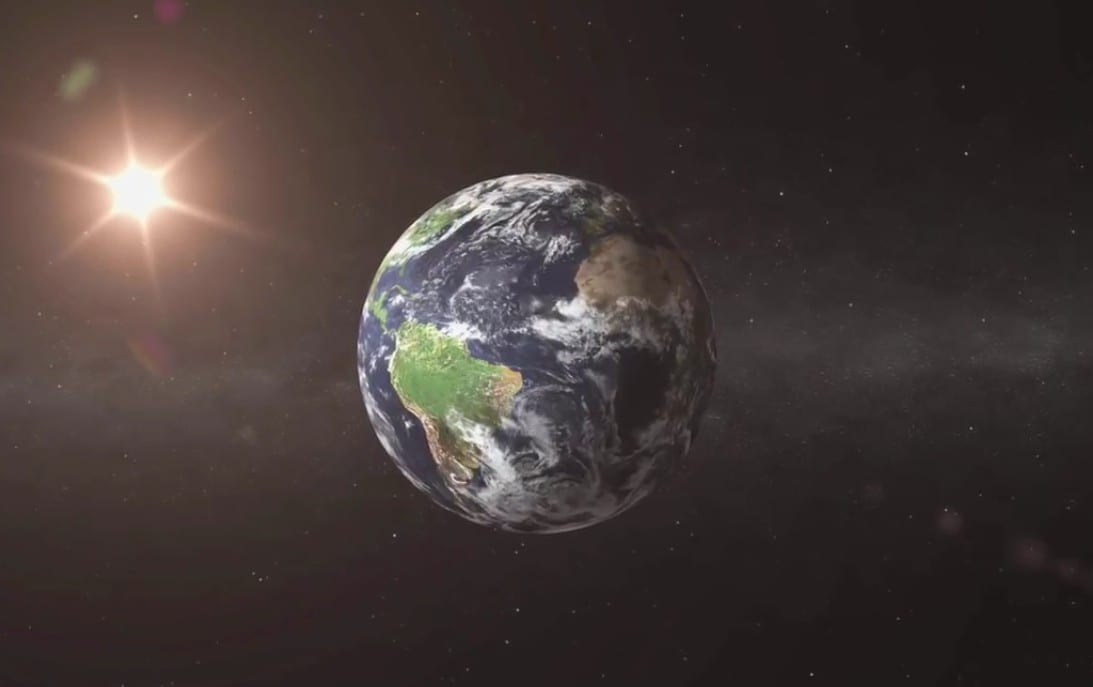There is some truth to this. But only some. The Torah is not a book of nature. But it is a book of what happens behind nature. Behind the physical world of the “what” are reasons of the “why”, the underlying spiritual reality of things.
In fact, Abraham discovered the whole Torah by looking at the physical world and intuiting the underlying spiritual implications of the world around him. Abraham's great innovation was that the spiritual and the physical worlds are exact parallels of each other, only on different planes of existence. But, we can hardly rely on the average man to duplicate Abraham's unparalleled genius in discovering the moral and spiritual plane from the physical. Therefore, we needed the Torah to know and have a relationship with God.
The harmony between the physical and the spiritual allows for some dialogue between Torah and science. The Torah tells us, for example, that the world had a definite beginning. The 19th century scientific theory of the static universe (claiming that the universe had always existed) was definitely in conflict with the Torah’s view that the world was created from scratch.
Today, the science-Torah dialogue has intensified. This is because, in the 21st century, the sciences in general, and theoretical physics and cosmology in particular, have captured as theirs for the answering, all the ancient questions of the philosophers: Where does life begin and end? When did the universe begin and when will it end? How is matter created and destroyed? What are the ultimate principles by which the universe runs? In fact, in 1988, Harvard naturalist Edward Wilson wrote a book attempting to unify all knowledge, including the knowledge of human affairs, under biology.
So, Torah and science do relate and can be in conflict.
Yet, the amazing thing is that while there are definite areas of incompatibility between modern science and Judaism, science has moved very rapidly in the direction of Judaism over the last century. While incompatibilities remain, they are getting smaller over time. My attitude is not to get frantic over the differences. Science is not a done deal. New discoveries lead to increasing approximations of the truth, and those approximations will lead to increasing reconciliations with what Judaism has been saying all along.
This is quite remarkable. A hundred years ago or more, a Jew would have been faced with huge contradictions between Judaism and science. Until the twentieth century, scientists thought the world to be completely deterministic, i.e. every effect has a clear cause which in turn is the effect of a previous cause, and so on ad infinitum.
Laplace, the nineteenth century Frenchman, went so far as to say that if we could know everything that had happened in the world until now, we could predict everything that would happen in the world from now on. This made belief in Divine Providence as well as freedom of choice very difficult. But, with the introduction of quantum physics, probability replaced certainty as the accepted idea in science. We can no longer know for sure what reality is; for example, we can no longer say where an atom is. What we can know are the various options of where it might be and the likelihood (probability) that it indeed be somewhere. This is not just because we do not have good measuring instruments or because our measuring instruments are somehow faulty. This is because uncertainty is actually built into the universe.
Since the collapse of the scientific world of certainty, there is no longer a contradiction between science and God’s Providence. The laws of science only represent the range of options which God normally uses to run his world. Which specific option He chooses and when He chooses to use the natural order cannot be predetermined.
The same is true of our freedom of choice. If the world is predetermined, then our choices are an illusion. But if the world is indeterminate, then there is place for choice.
This goes further still…
A fascinating experiment sends one photon of light at a time randomly through one of two slits in a screen to create a pattern on a second screen behind the first one. This second screen will show a series of dark and light bands where the light seemingly either interfered or reinforced each other as if there are two or more photons going through each slit simultaneously. The only explanation for this is that each photon must be going through both slits at the same time!
More amazingly, if someone were to try to measure which slit the photon was going through, the photon lands out going through whichever slit was measured. In some way, the measuring of the slit causes the photon to go through that slit, and that slit only. This led scientists to realize that observation actually causes a change in matter.
Many scientists claim that it is the mind itself which causes this change. Hence the concept of an “observer-centered universe” was born. As a leading physicist, David Deutsch, put it, “The arguments that humans don’t have a fundamental role in the scheme of things, which used to seem so self-evidently true, have all fallen away… One needs to… understand them in order to understand the universe in a fundamental way.” According to this, we not only have choice, but our choices actually shape the universe – a very Jewish idea.
And here is another remarkable example. Scientists have been searching for a theory which will combine all of the basic four forces of matter (the strong, weak, electromagnetic and gravitation forces ) into one force. Now there is nothing in science which says that there has to be one force instead of four. But, apparently, scientists believe in the ultimate unity of the universe. One cannot help noticing that this is highly consistent with a belief in an ultimate Creator. As Timothy Ferris put it, “Science from the beginning incorporated [the] idea that the universe really is a uni-verse, a single system ruled by a single set of laws. And science got that idea from the belief in one God.”
Few scientists ever stop to think that such a belief would only make sense in a monotheistic world. If there is one God who is the source of everything, then all things ought to be traceable back to a point where they are all one. But if there was no one Creator of everything, what’s wrong with four forces rather than one?
The Big Bang, the idea that the universe had a beginning, was another step towards Torah-Science reconciliation. Prior to that, scientific orthodoxy held that the world has always existed. In fact, for 60 years after it was first discovered in the 1920s, the Big Bang, with its frightening religious implications, was a disputed theory. It was only in the 1980s, when there were more than six proofs for the theory , that it was finally accepted.

Most scientists today would also accept some version of the anthropic theory, which states the world seems to have been set up (designed) to produce life. Nature turns out to be very exactly tuned. Change any law of nature even slightly, or change the initial conditions, and it becomes impossible for life to have emerged at all. Water, oxygen, minerals and many other things are perfectly suited in many ways for the tasks they fulfill. In fact it is impossible, in each case, to even imagine a theoretical substance which might do a better job. Critics argue that the universe is bound to look as if it were designed for our existence because we could only be here if the universe were adapted for our existence. That would be a good argument if the cosmos was adapted to some degree for life. But it appears that the cosmos are optimally adapted for life – that every constituent of the cell and every law of nature are uniquely and ideally fashioned to that end.
More than that, it is not only this or that variable that makes this argument so impressive. It is the accumulation of all the variables, all being there in exactly the proportion that they need to be, the lack of any one of them rendering life impossible. This has led many leading scientists to claim that the world was “designed” for life, even if they are careful not to say that God was behind that design. As Conway Morris puts it: if the tape of life were rerun form the Cambrian time, we would get almost exactly the same outcome as we have today.
I would argue that evolution, though still in some tension with Judaism, is a step closer towards Judaism than its Lemarkian predecessor. (And it has a lot more surprising elements of commonality with the major commentators than most people realize.) Certainly, the theory as such does not suggest a secular interpretation any more than a religious one, and while I do not want to engage in a “God of the gaps” explanation, I do see nothing anti-God about humans using their genetic alterations, social arrangements or anything else to provide a survival advantage. More importantly, I would expect future discoveries in paleontology and related fields to bring evolution closer to Judaism, not to take it further away.
All of these things reflect the increasing convergence of science and Judaism in all fields of scientific endeavor. The 19th century Jew would have faced a level of dissonance between the two far higher than that of the 21st century Jew. He would have lacked Einstein's insight that time contracts and expands, facilitating resolution of the age of the universe issue, or the idea that matter equals energy, enhancing our appreciating that behind matter lays a more ethereal, spiritual reality.
Having said that, there remains a source of great tension between Judaism and science. Science is based on a very definite world view. Science takes us ever so close to tying up the creation back to the Creator. But just at that point it stops and claims that that is all there is to it. Science separates itself from religion at the very point where it ought to be calling on an understanding of God to complete the explanation which it had begun. As such it is a secular endeavor.
Science discovers the Big Bang, but will then try desperately to avoid saying that that means that God created the world. Scientists uncover the anthropic principle, that nature seems to have direction and purpose towards life, but will not say that some Being therefore designed it that way.
The paradigm of science holds that it is unscientific to bring God into the picture. Even a religious scientist, and there are lots of them, would not dream of talking about God in a scientific paper.
The roots of this God exclusion paradigm go back to the Tower of Babel. The people at that time said: Come, let us build us a city and a tower, whose top may reach to heaven; and let us make for us a name, lest we be scattered abroad upon the face of the whole earth. (Genesis Chap 11, vs. 4)
A great city with a great tower in the middle to maintain the unity of the human race! What could be wrong with that?
The commentators explain, however, that the tower was being built as an instrument to conquer and bring under the control of man every aspect of the creation. Then they would be able to prevent God from using the heavens as an instrument for implementing His decrees against the earth. “Remove Divine Providence from the equation,” they said, “and we can then use science and medicine to give us a more secure, healthy, wealthy and happy existence.” They wished to cut off God's connection with the world in the belief that this would allow them to discover and harness all the scientific forces that would be needed for them to solve every sort of human misery.
Aware of the scope of the job at hand, they realized that only a United Nations far more powerful than the one we have today could hope to bring the necessary resources to bear in resolving the issues of illness, poverty, war and natural disaster. The idea of a world capital with its gigantic tower, a monument to human possibility, etched in every mind was just the solution for this challenge. Of course, a tower of this size was not just meant to be an empty monument. Its multi-purpose structure would serve as a center of science, a giant lightning rod, and a potential launching pad for future lunar expeditions.
The problem was not the desire to know more and to organize accordingly; it was that when God “came down” to look, He saw a rebellion, not a scientific venture. It was a tricky point – for God is surely pro-science. And hence the verses do not explicitly mention any sin. But, man was so desirous to control his environment that God was left out of the equation. They began to develop a scientific worldview that automatically filtered out God. The results were painful.
There are certain parallels to the science of today. The secular bias is, in the main, not deliberate . Rather, it exists as the natural framework with which scientific eyes view the world. What it needs is a paradigm shift, so that the natural filter for information accommodates God. Kuhn points out that the new paradigm may use the same words as the old, but it often means something completely different, making the old and new theories incomparable. A scientist in this new paradigm will see God written in every theory.
Perceptive scientists throughout the ages have achieved this insight at a basic level. They have marveled, Abraham-like, at how remarkable it is that higher, more abstract forms of thinking are in harmony with the physical world around us. Carl Gustav Jacobi, the 19th Century Prussian mathematician, remarked that “it is a remarkable fact that when man thinks in a pure system of abstract logic such as mathematics, that logic turns out to be consistent with the logic of the world .” Or, as Plato put it, “God ever geometrizes.”
These scientists reached the most basic level of a Monotheist. But nowhere do we see that they were able to take these observations and turn them into a personal God who makes moral and spiritual demands of them. At most, this represents what Alfred North Whitehead called a “widespread instinctive conviction in the existence of an order of things” . The God of the scientist is generally some great cosmic being, and the awe scientists feel when they look a little deeper seems to lead nowhere. A scientist can notice that the number Pi, 3.1415 is not only yielded by the division of the circumference of a circle by its diameter, but it turns up in equations that describe subatomic particles, light and other quantities that have no obvious connection to circles. He can then conclude, as John Polkinghorne did, that human-invented mathematics somehow tuned into the truths of the cosmos. But, why don’t scientists then take the next obvious step, which is to say that the reason that there is this harmony between our minds and the world is that they both come from the same Creator-Source – and that this Creator has a plan for us?
Scientific revolutions have happened before. Copernicus and Galileo led one that was rounded off by Newton. Einstein, Plank, Borne and Heisenberg led another one in the early part of this century. But, a scientific revolution which allows science to accommodate God is a revolution of a different order.
When Laplace presented his work to Napoleon, Napoleon reputedly remarked, “Monsieur Laplace, they tell me that you have written this large work on the system of the universe and you did not even mention its Creator.” To this Laplace supposedly responded, “I have no need for that hypothesis.”
But the world has come a long way since Laplace and his Napoleonic encounter. Recently, there have been many attempts to reconcile religion with science, not so much because of a change in attitude, but because scientific discoveries in the twentieth century seem to point in that direction. Fritjof Capra caused quite a stir when, in “The Tao of Physics”, he showed the basic harmony that exists between modern physics and Eastern religions. Michael Behe has made a powerful case for showing that biochemistry is leading us toward rather than away from the idea of a designer of the universe. These gentlemen have their point, but they miss the larger issue I wish to make here.
Science is drawing closer to religion in general and Judaism in particular. The idea that matter can turn into pure energy has made it easier to conceive of a purely spiritual world. The indeterminacy of quantum physics allows for freedom of choice and moral responsibility; the Big Bang is a step towards (though not a complete harmonization with) the creation story. But the closeness only consolidates the position of science as the embrace of all reality. It may be, as Robert Jastrow suggests in God and the Astronomers, that the scientist will ultimately get to the top of the cliff and find the theologian sitting there all along. But the scientist has no intention of joining the theologian, sitting side by side. The scientist sees the theologian as an extension of the cliff face which he must climb. He will keep on climbing until he is sitting, as he sees it, on top of the theologian as well. Of course he is gracious to his cliff, and he smiles kindly down on his theologian as well. All are welcome in the ultimate scheme of things.
But there is a different vision of things – one which we will witness in the Messianic era. In this scenario, science will become the handmaiden of spirituality, not its master. The enormous secrets still held in nature will be revealed to deepen our understanding of the ways of God and the Torah’s message. In this new dawn, science will not only actively serve spirituality; it will naturally flow from it, and provide yet another way of connecting to God.
Written by Rabbi Avraham Edelstein, Director of Neve College for Women





